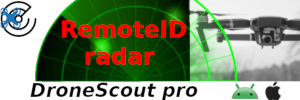- Joined
- Jan 9, 2017
- Messages
- 34
- Reactions
- 9
- Age
- 74
Finding my LG G4 too small as a monitor for my Mavic, I wanted to connect my Tab S instead. After a little thought, the mechanical part was actually quite simple, and this would work for any large tablet that the controller won’t wrap its arms around, with different dimensions of course. I used wood to avoid any possible degradation of radio or GPS signals.
I bought a piece of ¼” by 5½” poplar at Home Depot since that width was about the length of my phone, and ¼” was about the right thickness for the controller’s arms. I have a table saw so the next part was easy. I cut one piece about 7 ½” long, and then ripped a length of the four foot board down to 4¼” wide. I cut this 6 ½” long and then glued the two pieces together with the smaller piece 9/16” in from the outer edges of the larger piece to allow the controller arms to grab the wider piece without hitting the smaller piece. I left about 5/16” of the larger piece sticking above the smaller piece so it would fit into the notch on the controller bottom edge. (Photo 1 showing tape) View media item 272
The smaller piece thickness, along with the Scotch (Velcro) strips attached to it and my tablet, provide the space needed so the top of the controller’s arms don’t rub on the tablet back. (Photo 2)View media item 271I cut strips of the 1” wide fastener tape about 6” long and applied the matt side with the inside edges 1 5/8” apart, equally spaced from the center of the smaller piece and with equal space from each end. I matched this with the loop side on the back of my tablet, (Photo 3) View media item 273
allowing for vertical placement so the controller fit just above the tablet. (Photo 4)View media item 274
I used 3 pound tape and this seems to be about right. There are stronger gripping models, but I did not want to put excessive stress on the Amoled screen. If I have mechanical connection problems I could add a third strip. I cut the wood so about ½” sticks out below the tablet, in case I want to rest it on top of my belt buckle, or have the ability to add some kind of a harness later.
Now came the data connection. I put a standard cable with the USB A connector in the bottom of the controller and the Micro B end into my tablet and turned everything on – controller, Mavic and DJI GO. The tablet screen said “disconnected” and I could not make any adjustments to the software. I finally pulled the little Micro B to Micro B cable out of the side of the controller, and the software recognized the drone.
Other comments here have talked about using a tablet at the same time as connecting a power pack to the controller’s Micro B socket to extend battery life. Not sure if this works with Android since I haven’t tried it yet, but apparently when a Micro B is connected to the side with no source, the USB A is not active.
This is going to make it so much easier to see all the data on that GO screen!
View media item 275
I bought a piece of ¼” by 5½” poplar at Home Depot since that width was about the length of my phone, and ¼” was about the right thickness for the controller’s arms. I have a table saw so the next part was easy. I cut one piece about 7 ½” long, and then ripped a length of the four foot board down to 4¼” wide. I cut this 6 ½” long and then glued the two pieces together with the smaller piece 9/16” in from the outer edges of the larger piece to allow the controller arms to grab the wider piece without hitting the smaller piece. I left about 5/16” of the larger piece sticking above the smaller piece so it would fit into the notch on the controller bottom edge. (Photo 1 showing tape) View media item 272
The smaller piece thickness, along with the Scotch (Velcro) strips attached to it and my tablet, provide the space needed so the top of the controller’s arms don’t rub on the tablet back. (Photo 2)View media item 271I cut strips of the 1” wide fastener tape about 6” long and applied the matt side with the inside edges 1 5/8” apart, equally spaced from the center of the smaller piece and with equal space from each end. I matched this with the loop side on the back of my tablet, (Photo 3) View media item 273
allowing for vertical placement so the controller fit just above the tablet. (Photo 4)View media item 274
I used 3 pound tape and this seems to be about right. There are stronger gripping models, but I did not want to put excessive stress on the Amoled screen. If I have mechanical connection problems I could add a third strip. I cut the wood so about ½” sticks out below the tablet, in case I want to rest it on top of my belt buckle, or have the ability to add some kind of a harness later.
Now came the data connection. I put a standard cable with the USB A connector in the bottom of the controller and the Micro B end into my tablet and turned everything on – controller, Mavic and DJI GO. The tablet screen said “disconnected” and I could not make any adjustments to the software. I finally pulled the little Micro B to Micro B cable out of the side of the controller, and the software recognized the drone.
Other comments here have talked about using a tablet at the same time as connecting a power pack to the controller’s Micro B socket to extend battery life. Not sure if this works with Android since I haven’t tried it yet, but apparently when a Micro B is connected to the side with no source, the USB A is not active.
This is going to make it so much easier to see all the data on that GO screen!
View media item 275









